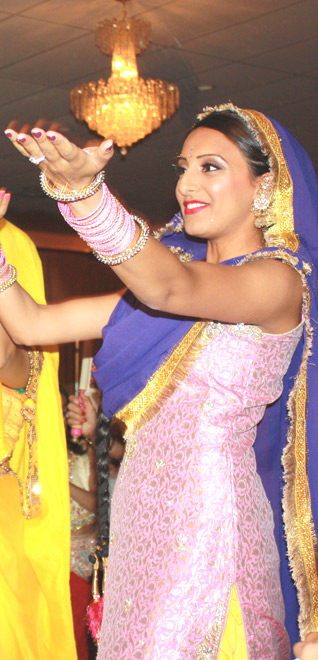Current Events
Come for the Giddha ... and Bhangra!
Vaisakhi Mela, New Delhi, April 13 - 17
NEWS REPORT
VAISAKHI MELA
April 13 - 17
New Delhi, India
The International Festival of Sacred Arts, part of The Attic (Amarjit Bhagwant Singh Charitable Trust) is back with a Vaisakhi Festival supported by Sir Sobha Singh Public Charitable Trust.
This festival explores Punjabi culture -- which stems from the oldest civilization known to man, the Indus Valley -- through its dances, music, textiles and art.
Punjab is the land of the Five Rivers and the birthplace of the Sikh Religion. In recent decades, it has survived a cataclysmic division of its region, followed by a long and dark phase of state terrorism and human rights violations by the government, and the responding resistance movement, militancy and independence movement, and is now, once again, the dominant and ascendant culture of the subcontinent.
The Punjabi chak de (go for it) attitude has resulted in a revival of the food, the music, the textiles and the spirit of this world wide community which numbers almost a quarter of a billion souls scattered in the diaspora. The spirit of Punjab now thrives not only in its capitals of Chandigarh and Lahore but in London, New York, Kuala Lumpur, Melbourne and Toronto. Above all, its evergreen sense of humour, steeped in chardi kalaa, rules the roost.
Saturday, April 13
2:30 to 4:00 pm
Giddha and Bhangra Workshop
Conducted by Tripat Kaur Dhillon
This free workshop is an introduction to the two great dances of Punjab: Giddha for women, and Bhangra for men.
Age: above 10. Participation by registration only. Call 23746050 or email:info@theatticdelhi.org
Giddha is a popular folk dance of women in the Punjab in both India and Pakistan. The dance is often considered derived from the ancient ring dance and is just as energetic and colourful as the Bhangra. It creatively displays feminine grace, elegance and elasticity and is mainly performed at festive or social occasions.
The costume is a colourful salwar kameez or ghaggra with heavy jewellery. The rhythm is kept by a dholak and clapping of hands. It is essentially danced in a circle where the women sing “boliyan” (couplets) which are emotional, humorous, teasing and cover themes ranging from nature to the excesses committed by the husband or mother-in-law.
Bhangra refers to several styles of dances from pre-partition rural Punjab. What came to be known as Bhangra was a particular type of dance to celebrate the harvest at the time of Vaisakhi (13 April).
After the Partition of Punjab, it had lost its popularity and was being slowly revived as “the folk dance of Punjab“. Its real resurgence however was in the 1980’s by Sikh-Britons, often characterized by a fusion with Western dance styles and the use of pre-recorded audio mixes. The infusion of rock resulted in a new “Bhangra Music” style, a music genre which has now become a worldwide phenomenon.
The music moved away from the simple and repetitive folk music beat and signalled the development of a self-conscious and distinctively rebellious British youth culture centered on an experiential sense of self, with its own language, gesture, bodily signification and, above all, masculinity. This music fostered a sense of affirmation of a positive identity and culture.
A similar phenomenon took place in the U.S. where a large community of Sikhs have often created their own subculture, complete with music, dance and inter-college Bhangra competitions.
Meanwhile back at home Bhangra dance is based on music from a dhol, folk singing, and the chimta. The accompanying songs are bolis (accompanying verses).
Bhangra singers employ a high, energetic tone of voice. Singing fiercely and with great pride, they typically add nonsensical, random noises to their singing. Likewise, often people dancing to Bhangra will yell exclamations such as “hoi, hoi, hoi“; “balle balle“; “chak de“; “oye hoi“, “Harappa”, to the music.
Traditionally, men wear a chaadar/lungi, a kurta and the puggrri.
WORKSHOP LEADER
Tripat Kaur Dhillon has worked with All India Radio and Doordarshan for 15 years as a voice-over artist. She has performed lead roles in the plays Chan Badl Da, Dard Ayega Daby Payoon, Sulagdey Daryaa, Terey Merey Lekh and Mirza Ghalib. She is featured in the first giddha video cassette, “Giddha Paa-o Kurriyo,” and in many Punjabi folk song videos. She has travelled as a dancer and as an actor in the Middle East, Africa, Canada and the UK.
She is presently working as a judge in the Punjabi Academi and in Punjabi University, Patiala.
Read tomorrow for more events …
April 6, 2013
Conversation about this article
1: Harinder Singh 1469 (New Delhi, India), April 06, 2013, 2:23 PM.
Such events are a must-see. They are important for our youth. I often wonder, once our children grow up, will they preserve our traditions, or -- hopefully -- do even better than what we have done? I will surely attend this time and add more mustard - saffron-sunflower outfits.
2: Ramesh Kumar (Tohana, Haryana, India), October 04, 2013, 6:30 AM.
Good site!



